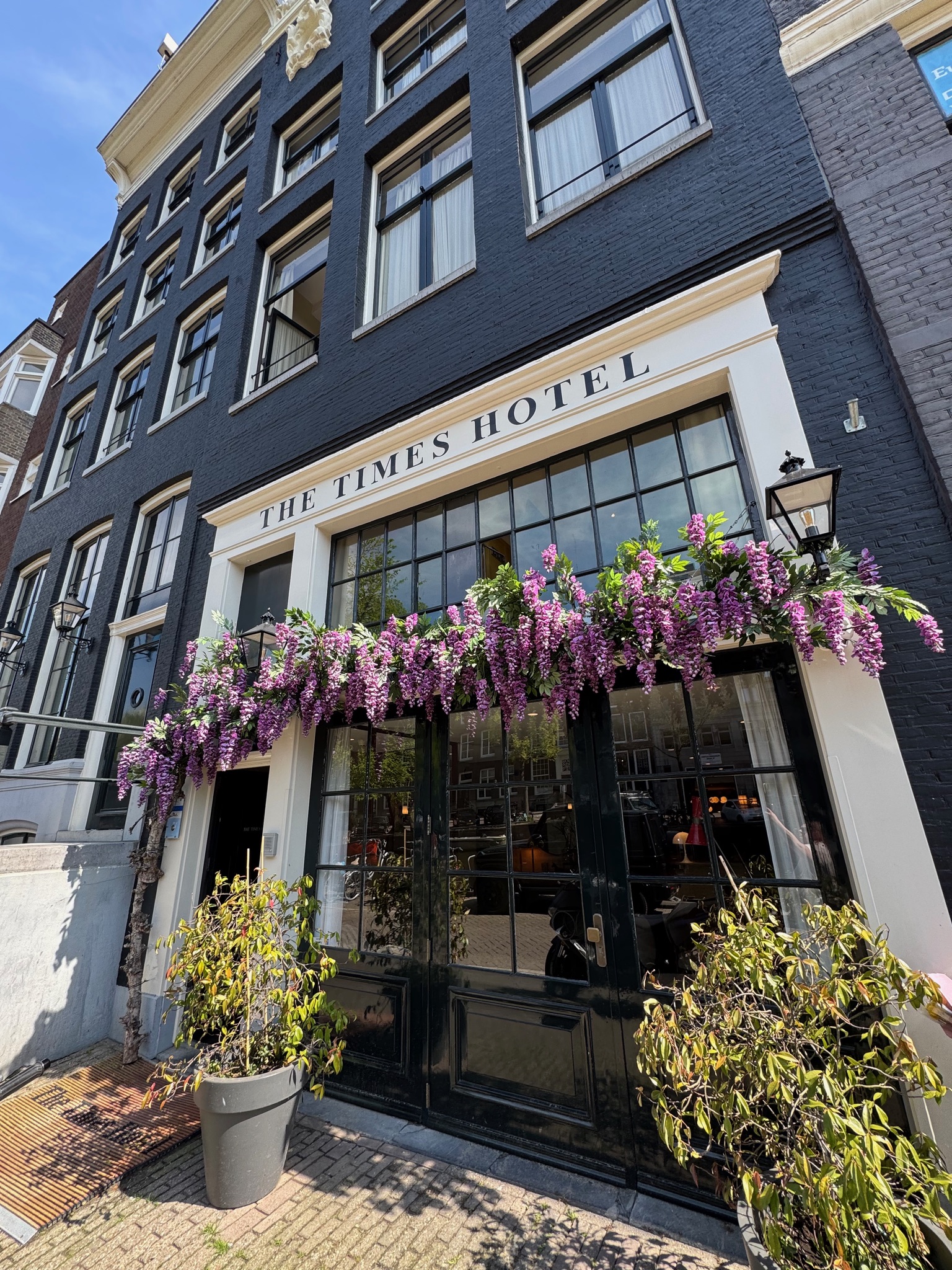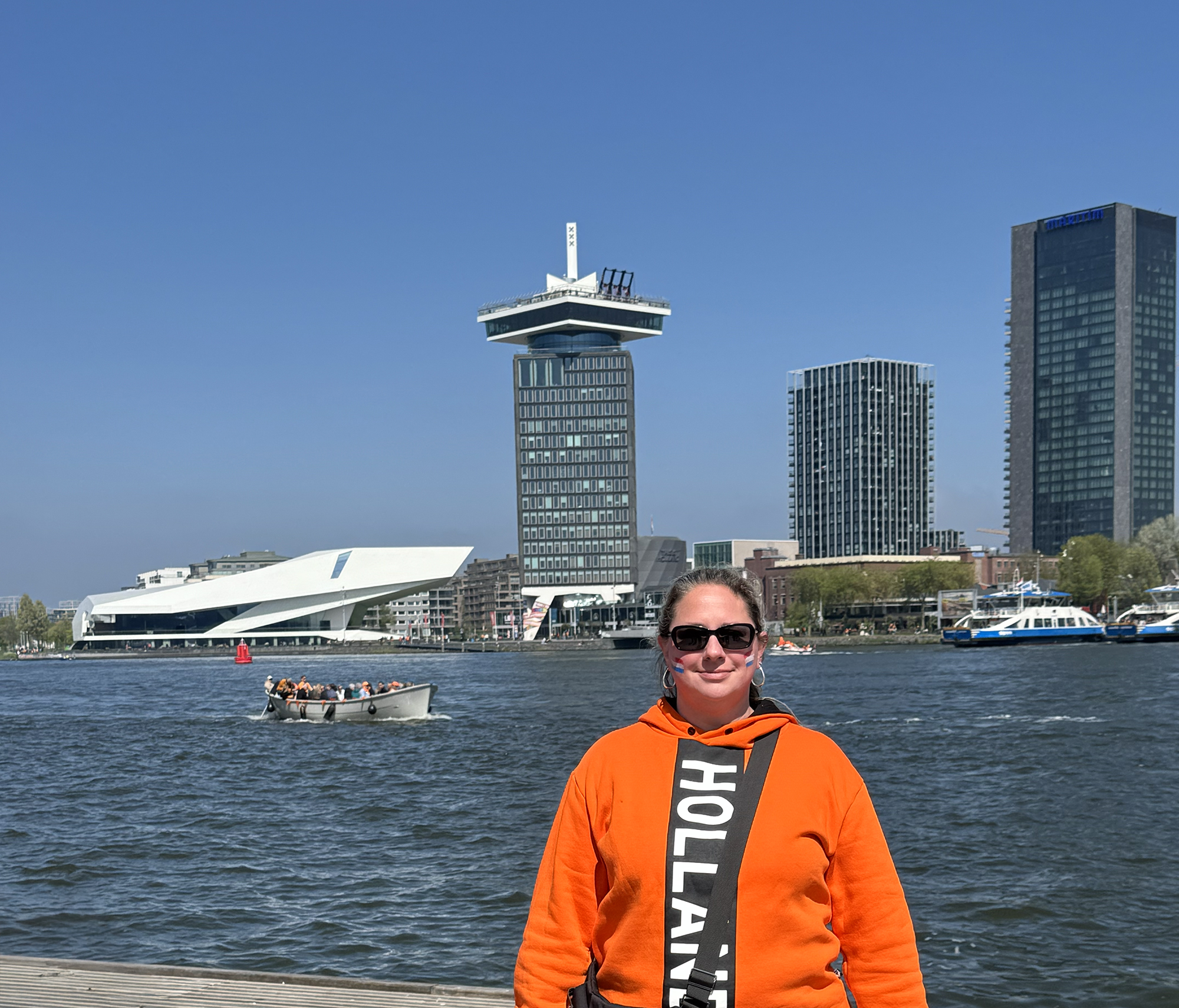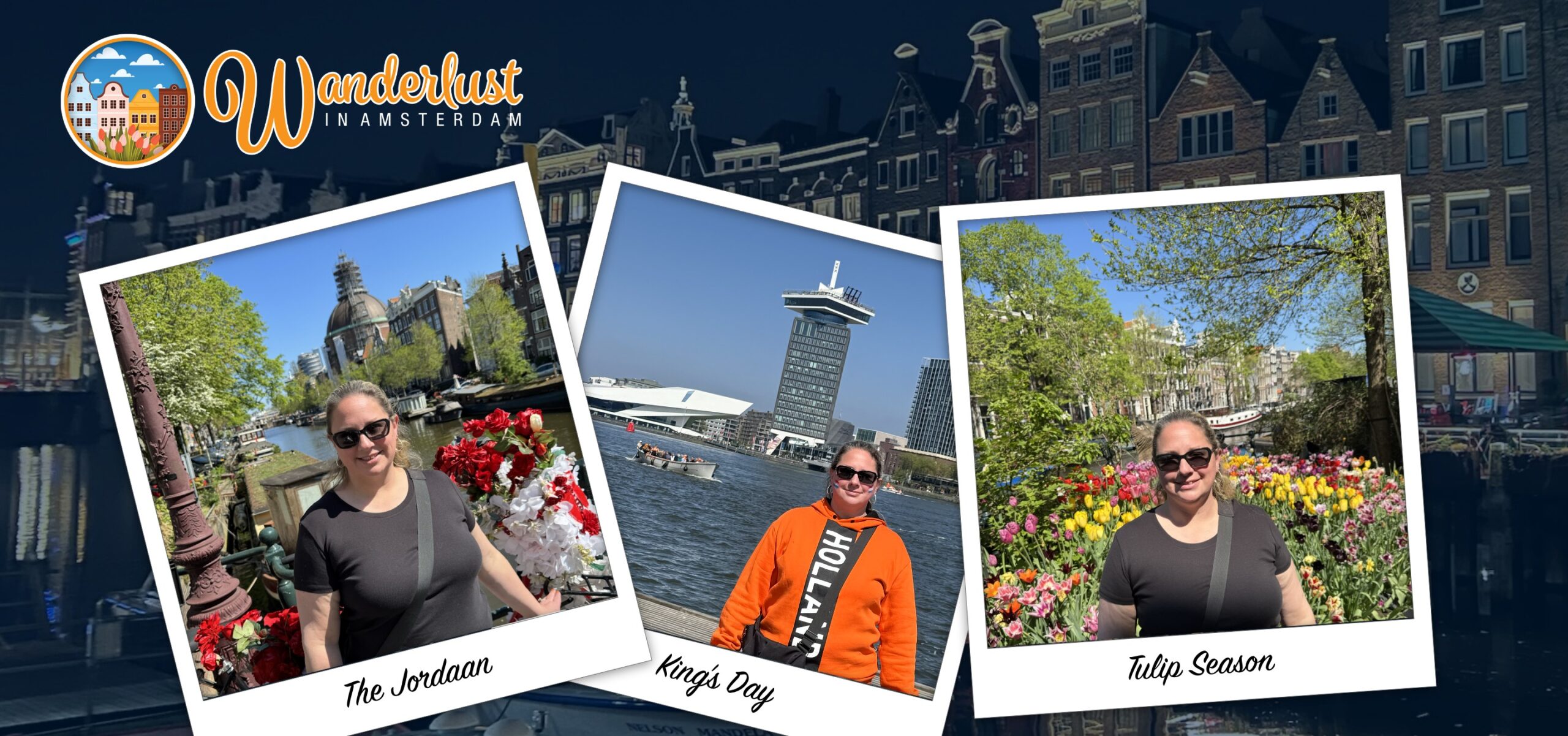Amsterdam may be known for its canals, tulips and cycling culture, but where you choose to stay can shape your entire experience in the city. After dozens of trips, we always like to stay in the Northern section of the Jordaan Neighborhood. This is the area where the canal ring is the best, plus there are cafes, bakeries, restaurants and shops where we have grown a connection too.
But this is not my recommendation for everyone, especially those who are looking for budget accommodations. Each neighborhood tells its own story, blending historical charm with modern energy. From the bustling activity around Central Station to the artsy calm of Noord and the refined greenery of Oud Zuid. Amsterdam offers accommodations for every kind of traveler. Here’s a guide to our favorite hotels across the city’s most interesting neighborhoods, each with its own vibe and appeal.
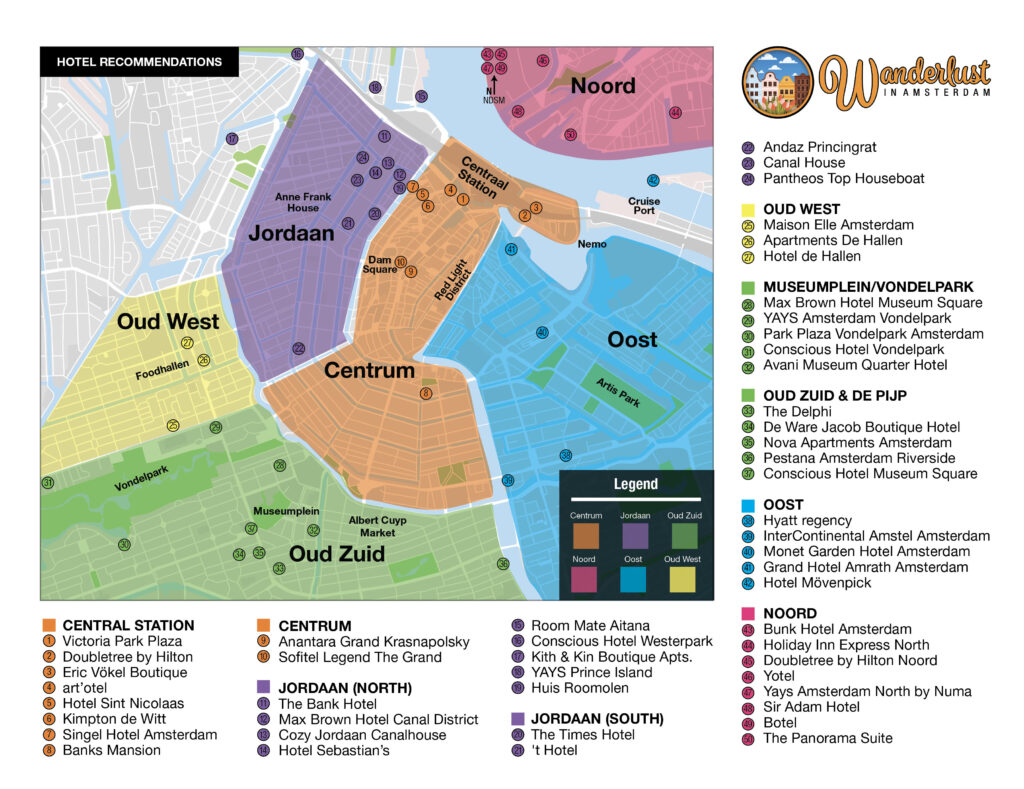
Table of contents
Amsterdam Centrum: Central Station & Dam Square
Amsterdam Centrum is the main tourist area found just south of the train station called Central Station. The Centrum district is the historic heart of Amsterdam and includes some of the city’s oldest streets, grandest buildings and most iconic canals. This area dates back to the 13th century, and much of its original charm remains intact with narrow alleyways, leaning gabled homes and centuries-old churches. While it draws millions of tourists each year, locals still live and work in this part of town, giving it an authentic buzz.
Today’s Centrum is fast-paced and always in motion. It’s where you’ll find the Royal Palace on Dam Square, the Red Light District, bustling shopping streets and a constant flow of canal boats gliding by. This area is ideal for first-time visitors who want to be within walking distance of major landmarks, restaurants, museums and nightlife. Travelers staying here can expect a lively atmosphere and plenty to see right outside their door.
History of the Centrum Area
Amsterdam’s Centrum is the oldest part of the city, originally built around a dam on the Amstel River in the 13th century. Over time, the city grew in concentric rings of canals, forming the now-iconic canal belt, or Grachtengordel, that surrounds the medieval core. By the 17th century, during the Dutch Golden Age, the Centrum flourished as a hub of global trade, finance and culture. Landmarks like the Royal Palace and Nieuwekerk reflect the city’s historical wealth and influence. Today, remnants of this rich past are visible in the architecture, cobblestone streets and canal views that define the area—though it now buzzes with modern commerce, tourism and vibrant street life.
Hotel’s in Centrum
The Central Station area is one of the busiest and most convenient spots in Amsterdam. It serves as a gateway to the city, with direct train access to Schiphol Airport and connections to trams, metros and ferries. Historically, this neighborhood has always been a hub of activity and commerce. Today, it buzzes with tourists, business travelers and locals on the go. Ideal for travelers who want easy access to transportation, major landmarks and round-the-clock action.
- Victoria Park Plaza
- Doubletree by Hilton
- Eric Vökel Boutique Apartments (1-3 bedroom apartments)
- Art’otel
- Hotel Sint Nicolaas
- Kimpton de Witt
- Singel Hotel
- The Panorama Suite (Mandelahuisje)
Dam Square and the Canal Ring areas are the most busy in all of Amsterdam. This is not my favorite spot to stay, however it is extremely centrally located. You will only be steps away from the top spots to visit as a tourist and all the best restaurants. The Anantara Grand Krasnapolsky and Sofitel Legend are both in Dam Square. The Banks Mansion is very popular with tourists, especially those who want to be close to attractions as well as night life.
The Jordaan Neighborhood
Once a working-class neighborhood filled with warehouses and factories, the Jordaan has transformed into one of Amsterdam’s most beloved areas. With cobblestone streets, leafy canals and historic buildings, it’s perfect for those who want to experience the city like a local. Today, the Jordaan is a blend of quaint charm and artistic flair, with indie boutiques, art galleries and cozy eateries around every corner. It’s ideal for couples, creatives and travelers seeking a quieter, but still central location to stay.
History of the Jordaan Neighborhood
The Jordaan was originally built in the early 17th century as a working-class neighborhood for laborers, artisans and immigrants during Amsterdam’s Golden Age. Its narrow streets and tightly packed buildings were a sharp contrast to the grand canal houses nearby. Over the centuries, the area became known for its strong sense of community, political activism and creativity. Home to many artists, including Rembrandt in his later years. By the mid-20th century, the neighborhood had declined, but thoughtful revitalization efforts transformed it into one of the city’s most desirable areas. Today, the Jordaan blends historic charm with modern elegance, offering leafy canals, art galleries, cozy cafés and a local, lived-in feel.
Hotel’s in the Jordaan
Travelers who want to experience the authentic heart of Amsterdam will feel right at home in the Jordaan. This neighborhood offers a peaceful, residential atmosphere just steps from the city center. It’s perfect for those who appreciate historic streets, charming canals and a slower pace. You won’t find big chains here… just local boutiques, tucked-away restaurants and morning markets that give a real sense of everyday Dutch life.
- The Bank Hotel
- Max Brown Hotel Canal District
- Cozy Jordaan Canalhouse (studio apartment)
- Hotel Sebastian’s
- Room Mate Aitana (IJ river view)
- Conscious Hotel Westerpark (eco friendly)
- Kith & Kin Boutique Apartments
- Huis Roomolen (studio apartment)
- YAYS by Numa Prince Island (2 bedroom apartments)
If the 9 Streets Shopping area is your draw to the Jordaan, stay in the South Jordaan. This area is also great for those wanting easy access to the Museumplein or nightlife in Lidesplein. Here is a great variety of accommodations in the Southern part of the neighborhood.
- The Times Hotel
- ‘t Hotel
- Andaz Princingrat
- Canal House (Mr. & Mrs. Smith property)
- Pantheos Top Houseboat
The Oud-West Neighborhood
Oud West is where local life meets cool city vibes. It’s a residential area that has become increasingly trendy, thanks in part to the Foodhallen and De Hallen cultural complex. Once a quiet, working-class neighborhood, Oud West has evolved into a hotspot for foodies, digital nomads and trendy travelers. Expect tree-lined streets, unique concept stores and a casual atmosphere. It’s ideal for visitors who want a more authentic, neighborhood-based stay without sacrificing convenience or character.
History of the Oud-West Neighborhood
Oud-West began to take shape in the late 19th century during a period of rapid urban expansion beyond Amsterdam’s canal belt. Originally built to accommodate the growing working-class population, the neighborhood was designed with wide streets, brick buildings and modest housing. Over time, it became a diverse and densely populated area with a mix of cultures and trades. While it remained relatively under the radar for decades, recent years have seen Oud-West transform into one of the city’s most up-and-coming districts. Redevelopment projects like De Hallen helped breathe new life into its historic spaces, turning old tram depots and warehouses into hubs for food, art and design. Today, Oud-West blends its working-class roots with a modern creative spirit that appeals to locals and visitors alike.
Hotel’s in Oud-West
- Maison Elle Amsterdam
- Apartments De Hallen (1 bedroom apartments)
- Hotel de Hallen
This neighborhood is a small triangle with less hotel offerings. However, the location is extremely close to Vondelpark so staying at a hotel near vondelpark will allow easy access to Oud-West.
Museumplein & Vondelpark
Museumplein is the cultural heart of Amsterdam, home to the Rijksmuseum, Van Gogh Museum and Stedelijk Museum. Nearby Vondelpark offers a peaceful escape in the middle of the city. This area is best suited for travelers who prioritize museums, art, culture and green spaces. It’s upscale but accessible, popular with couples, solo travelers and senior travelers.
History of Museumplein and Vondelpark
Museumplein and Vondelpark sit at the cultural and green heart of Amsterdam. The area developed in the late 19th century, shaped by the construction of the Rijksmuseum and the subsequent transformation of the surrounding space into a formal museum district. Museumplein was designed as an elegant public square to complement the city’s growing collection of world-class museums, including the Van Gogh Museum and Stedelijk Museum. Its open lawns and grand architecture made it a natural gathering place for locals and visitors alike.
Vondelpark, just a short walk away, opened in 1865 as a landscaped public park and has remained a beloved green escape ever since. Named after the Dutch poet Joost van den Vondel, the park was intended as a cultural and leisure space for the city’s growing population. Over the years, both areas have maintained their prestige and popularity, attracting art lovers, families and anyone seeking peace, beauty and inspiration in the heart of the city.
Why stay near Museumplein and Vondelpark
Staying near Museumplein and Vondelpark is perfect for travelers who want to combine world-class culture with a serene atmosphere. This neighborhood offers easy access to the city’s top museums, beautiful architecture and plenty of green space for strolling or relaxing. Whether you’re starting your morning with a jog through the park or spending the afternoon surrounded by masterpieces, this area offers a refined and relaxing way to experience Amsterdam.
Hotels in Museumplein/Vondelpark
- Max Brown Hotel Museum Square
- YAYS by Numa Amsterdam Vondelpark
- Park Plaza Vondelpark Amsterdam
- Conscious Hotel Vondelpark (eco friendly)
- Avani Museum Quarter Amsterdam Hotel
De Pijp & Oud Zuid Neighborhoods
Oud Zuid and De Pijp are elegant neighborhoods, diverse and full of character. Oud Zuid is known for its stately homes and upscale boutiques, located just south of the canal ring. De Pijp is a neighborhood in Oud Zuid, a vibrant, multicultural spot famous for the Albert Cuyp Market. Travelers looking for a balance of charm, culture and local energy will find these neighborhoods ideal. They are especially appealing to returning visitors who want a more residential experience.
History of De Pijp & Oud Zuid
De Pijp was developed in the late 19th century to relieve overcrowding in the city center, quickly becoming home to a diverse mix of working-class families, immigrants and artists. Its narrow streets and small apartments gave rise to a vibrant street culture, and it became known for its bohemian spirit. The Albert Cuyp Market opened in 1905 and remains one of the most iconic landmarks in the neighborhood. Over time, De Pijp evolved into a lively, multicultural area filled with eateries, galleries and cafes—popular with students, creatives and young families.
Oud Zuid (Old South) was built in the same era but with a different vision. It was designed as an upscale residential district, home to stately mansions, elegant avenues and cultural institutions like the Rijksmuseum and the Concertgebouw. While De Pijp buzzes with youthful energy, Oud Zuid offers refinement and calm, with leafy streets, luxury boutiques and proximity to the city’s top museums. Together, these neighborhoods reflect two distinct but complementary sides of Amsterdam’s identity.
Hotels in De Pijp & Oud Zuid
- Conscious Hotel Museum Square
- The Delphi – Amsterdam Townhouse
- De Ware Jacob Boutique Hotel
- Nova Apartments Amsterdam (1-2 bedroom apartments)
- Pestana Amsterdam Riverside (de Pijp)
Amsterdam Oost Neighborhood
Amsterdam Oost has long been a gateway for change and diversity. Originally developed in the late 19th and early 20th centuries to accommodate a growing population, it quickly became one of the city’s most multicultural neighborhoods. The area was home to factories, dockworkers and immigrant communities, giving it a rich mix of cultural influences and working-class character. Over the years, Oost has undergone significant transformation, with many industrial buildings and older housing blocks repurposed into creative spaces, modern apartments and green public areas. The neighborhood now blends its historic roots with a renewed energy driven by students, artists and entrepreneurs. From the majestic Tropenmuseum to the vibrant Portuguese Synagogue, Oost reflects Amsterdam’s past while embracing its future.
History of Amsterdam Oost
Amsterdam Oost has long been a neighborhood shaped by movement, industry and multicultural influence. Developed in the late 19th century to accommodate a growing population beyond the canal belt, Oost was once home to workers, dockyards and textile factories. Its eastern location also made it a landing point for new immigrants, giving rise to a rich blend of cultures that still defines the area today. While parts of Oost fell into decline in the mid-20th century, the past two decades have seen a creative resurgence, with repurposed industrial buildings, lively markets and diverse food scenes breathing new life into the district. Today, Oost is where old Amsterdam meets the energy of what’s next.
Why stay in Amsterdam Oost
Amsterdam Oost is perfect for travelers who want a more local, laid-back experience without straying too far from the city center. It offers a blend of history, culture and urban renewal that appeals to curious and open-minded visitors. Here you’ll find beautiful parks, diverse cuisine, cultural institutions and a thriving café scene. It’s ideal for those who enjoy exploring beyond the tourist core—whether it’s shopping at neighborhood markets, discovering independent galleries or just relaxing in a leafy square. Oost is popular with students, creatives, families and long-stay travelers looking for authenticity and space to breathe.
Hotels in Amsterdam Oost
Oost Oost is a dynamic neighborhood where tradition meets modern innovation. With a mix of classic architecture and contemporary spaces, this area is popular with students, expats and curious travelers. It offers green parks, museums and an evolving food scene. A bit off the main tourist track, Oost appeals to travelers who want a deeper dive into the real Amsterdam.
- Hyatt regency
- InterContinental Amstel Amsterdam
- Monet Garden Hotel Amsterdam
- Grand Hotel Amrath Amsterdam
- Hotel Movenpick
Amsterdam Noord Neighborhood
Noord Just a (free) ferry ride away from Central Station, Noord feels like a different city altogether. Once industrial, it’s now a playground for artists, designers and tech startups. With bold architecture, waterfront views and repurposed warehouses, Noord is the future-forward face of Amsterdam. Ideal for adventurous travelers, creative types and anyone looking to stay somewhere unique.
History of Amsterdam Noord
Amsterdam Noord’s story is one of transformation and reinvention. For much of its history, Noord was an industrial and maritime hub, home to shipyards, warehouses and factories lining the IJ River. It was largely separate from the city center, accessible only by ferry or bridge, which gave it a distinct working-class character. In recent decades, however, Noord has undergone a dramatic makeover. Old docks and industrial buildings have been repurposed into creative spaces, trendy restaurants and cultural venues. The arrival of new residential developments and innovative projects like the NDSM Wharf have turned Noord into one of Amsterdam’s most exciting and forward-looking neighborhoods. Its blend of rugged industrial heritage and cutting-edge design attracts artists, entrepreneurs and adventurous visitors alike.
Why Stay in Amsterdam Noord?
Amsterdam Noord is a fantastic choice for budget travelers who want to stretch their euros without sacrificing style or experience. The neighborhood offers affordable accommodations ranging from hostels to budget hotels and unique stays like houseboats, all with a cool, creative vibe. With plenty of hip cafés, street art, and cultural spots to explore, Noord gives you an authentic Amsterdam feel away from the pricey city center. Plus, the free ferry ride from Central Station makes getting to and from downtown quick and easy. If you’re looking for wallet-friendly lodging in a lively, artsy neighborhood with great views and plenty to do, Amsterdam Noord is a smart pick.
Getting to Amsterdam Noord
Taking the free ferry to Amsterdam Noord is quick and easy, you don’t even need a ticket. Go to the back of Central Station, near the IJ River until you see four ferry terminals. The Buiksloterweg ferry runs 24/7 and is the most popular with tourists. The A’dam Tower, This is Holland and Film Eye are all located just steps off the ferry. The ferry line NDSM is the other popular route with visitors, especially those with creative and alternative interests. The IJplein and Ponsteiger ferry lines are typically used by residents and do not have many tourist attractions or hotels.
Hotels in Amsterdam Oost
Be sure to know which Ferry you need to get to your Noord hotel, there are two main ones: NDSM & Buiksloterweg. The laster hotels are located in NDSM, a 10 minute ferry vs. Buiksloterweg’s 5 minute ride.
- Sir Adam Hotel, part of Sircle Collection
- The Panorama Suite
- Holiday Inn Express Amsterdam North
- Yotel
- Botel (NDSM)
- Bunk Hotel Amsterdam
- Doubletree by Hilton Noord
- Yays Amsterdam North by Numa (2 bedroom apartments)
Final Thought on Hotel’s in Amsterdam
Where you stay in Amsterdam can shape your experience as much as what you see. Whether you want historic charm, cutting-edge design, local markets or canalside serenity, there’s a neighborhood—and a hotel—to match your travel style. Use this guide to find the one that feels just right for you.
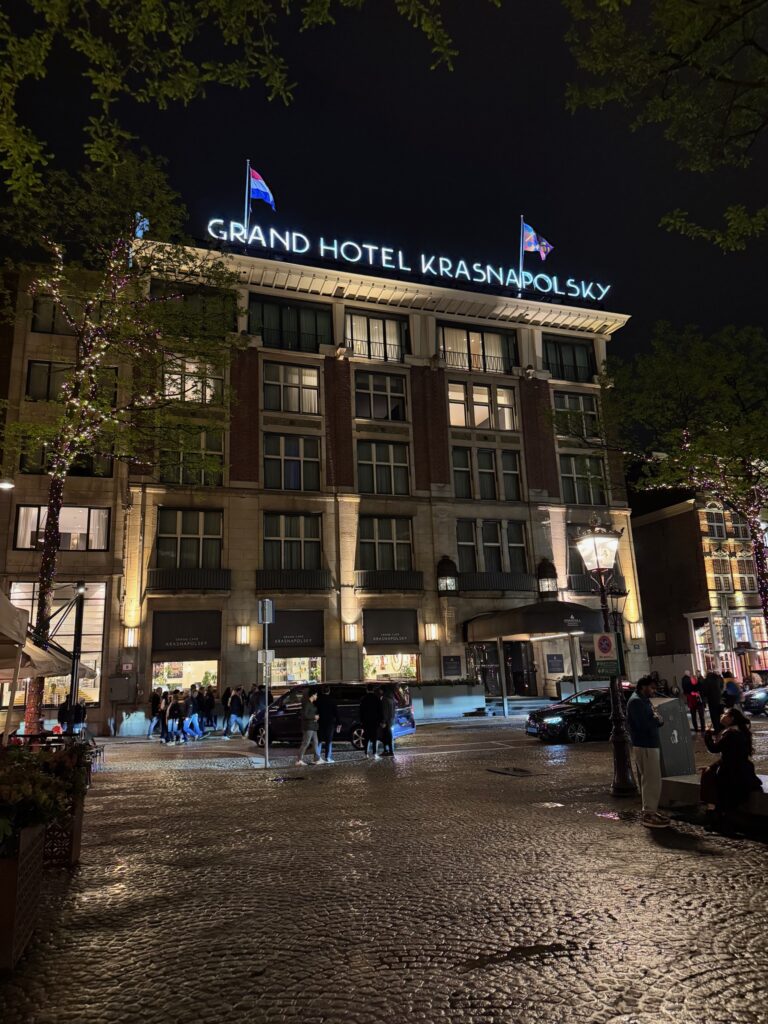
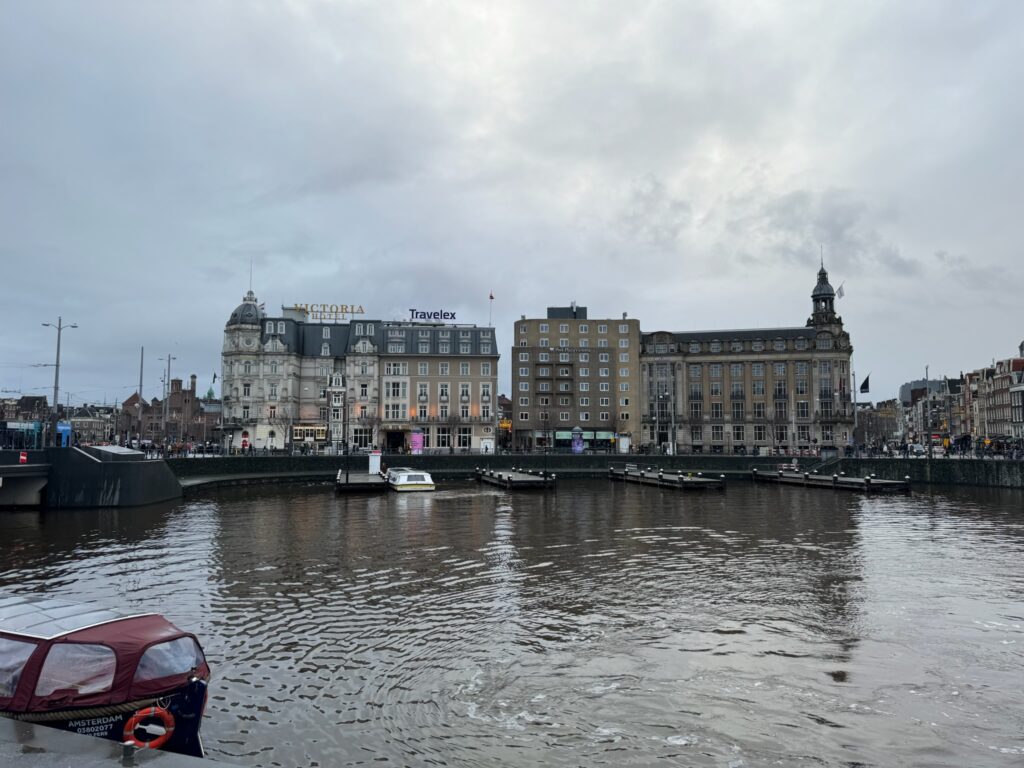
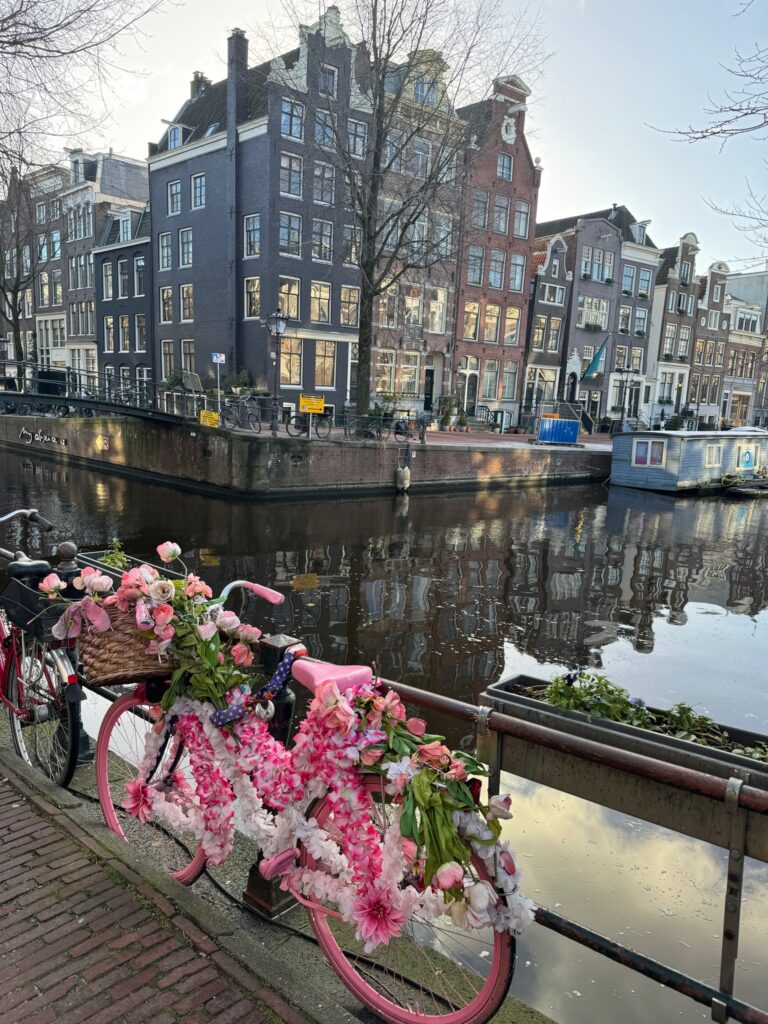
What is Wanderlust in Amsterdam?
Check out my website at LauraMarieMyers.com/wanderlust to read additional Amsterdam blogs, see all my best Amsterdam recommendations and download my free Amsterdam Bucket List. Newsletters are coming soon to get inspiration for your own travels and adventures. Join my email list so you never miss a blog. As an Amsterdam travel consultant, let me help you make the most of your time and budget in Amsterdam, no matter how much time you have to spend!

